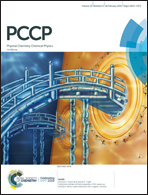Potential energy surface and rovibrational bound states of the H2–C3N− van der Waals complex†
Abstract
Since their recent detection in the interstellar medium, anions have raised the question of their possible mechanisms of formation, destruction and excitation. This requires knowledge of their interaction with the most abundant interstellar species. In the present work, a four dimensional rigid rotor model of the potential energy surface is developed for the collision of C3N− with H2. Ab initio calculations are performed with explicitly-correlated coupled-cluster theory via CCSD(T)-F12/aug-cc-pVTZ. Two linear equilibrium structures are found, different in the orientation of C3N−. Two more equilibrium structures, symmetrically equivalent, are obtained by the permutation of H atoms. The vibrational dynamics is mainly controlled by the considerable difference between the two bending frequencies that correspond to the hindered rotations of C3N− and H2. This arises from the potential energy surface which is soft for rotation of C3N− and stiff for rotation of H2, and also from the large difference in mass between both monomers. Although a high potential barrier prevents the rotation of H2, a significant tunneling effect is observed which causes a splitting in the degenerate energy levels. On the contrary, the rotation of C3N− is allowed since the energy of the saddle points is lower than the energy of the bound states, but the wavefunctions remain localized around each linear structure unless a large excitation energy is available.

- This article is part of the themed collection: 2019 PCCP HOT Articles


 Please wait while we load your content...
Please wait while we load your content...